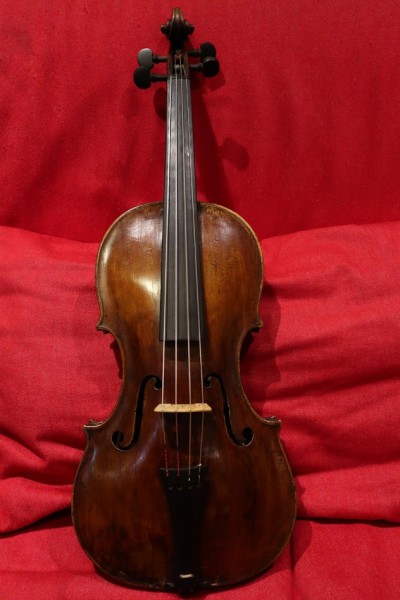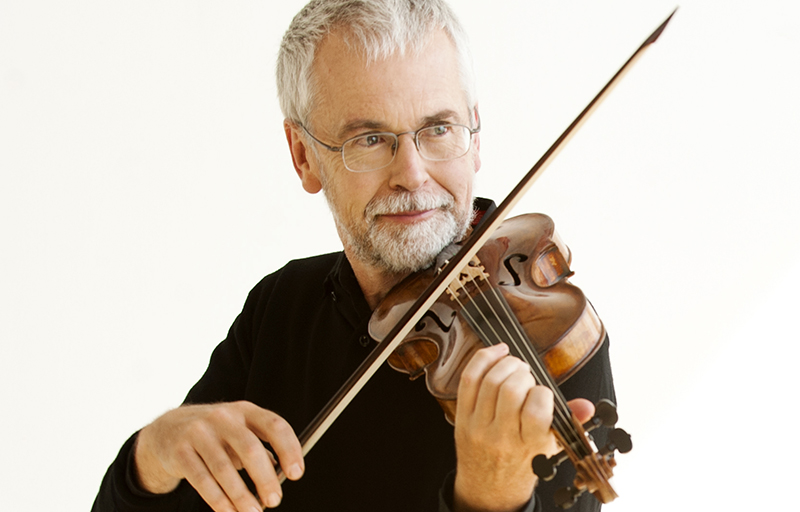By Thomas Georgi, violinist/violist (and sometimes viola d'amorist)
Choosing a new violin/viola/cello/bass is not easy. Even for players with extensive experience, quality of tone, projection, and ease of response are hard to assess with confidence.
At the beginning of their careers, string players often turn to violin dealers for assistance in acquiring a violin. This seems straight forward enough, but does have something in common with the dilemma Jemima Puddleduck found herself in when turning to the Sandy-Whiskered Gentleman for help with her nest. After a while people turn to alternative sources of instruments, instrument makers, auctions, and word of mouth.
From time to time, members of the Tafelmusik string section bring new instruments to rehearsals, to seek opinions from their colleagues as to whether an instrument can do the job, and to hear how an instrument sounds in a hall.
In June of 2018, my colleague Cristina Zacharias asked for my opinion on a violin that had just come in, that she was considering purchasing for Tafelmusik for possible use by the students in our artist-training programs, such as TBSI (Tafelmusik Baroque Summer Institute).
Beginner-level instruments are a straightforward acquisition. They cost a few hundred dollars and sound reliably mediocre.
The serious TBSI student/pre-professional is already at the next-level instrument. For them something better is needed, and choosing gets more difficult as well as more expensive. Mid-range instruments usually have a price tag ranging anywhere between $2,000 and $25,000. Instruments in this range can sound very, very good, or they can sound poorly; mostly they sound ok. When they sound amazing, the choice is easy. The difficulty comes when choosing between decent-sounding, unexceptional instruments.
The upper range of bowed strings, the famous instruments you sometimes read about in the media, are seldom available to members of the Tafelmusik orchestra, although this violin and this cello are members of that exclusive club. The extraordinary value attached to the upper end of the bowed string market is why you have never heard the instruments of Stradivari or Guarneri at Tafelmusik concerts, even though these makers undeniably made baroque instruments.
I looked at the violin Cristina had with her, and saw some problems. There were some serious cracks in the lower back of the instrument, and blemishes in both the treble and bass side ribs that looked like they might be symptoms of major structural issues.

But I liked the arching of this violin, both the belly and the back. The arching of belly and back of a bowed stringed instrument is, to a great degree, its identity, and the signature of its maker. This fiddle's arching is not as fully worked out as it would have been on a true Nicolo Amati violin, the Italian maker it was intended to be a copy of, but it is full and even, better than many German made violins of the baroque. Although this violin is likely to be most of 200 years old, there is no sag in the middle of the belly due to the pressure of the strings, which I thought was a promising sign.
So I wondered if the violin might be something for one of my own students. When I asked after the owner, he turned out to be a Tafelmusik subscriber who had inherited the violin from his aunt, who had in turn bought it from a violin shop in Munich in September 1985 for 3,000 DM. After his aunt died, and the fiddle had spent over a decade in his closet, the owner was dismayed to be told by violin shops here in Toronto that the violin would cost more to fix than it would sell for. The violin had become “Homeless.”
Who made this violin? When, and where did it come from? I can’t answer these questions for certain. The violin has a Nicolo Amati label in it with the year 1679, but labels are seldom original, and the Latin words are spelled differently than on an authentic Nicolo Amati label. Spelling was not yet fixed at that time, though, and the spelling variations add to the impression I was already forming from the shaping of the body, that the makers meant to make an Amati-type violin, but were working from memory, without an Amati in front of them to copy. When I went to obtain a new insurance appraisal for Homeless, the appraiser suggested that the body of the violin was likely to be from early 19th-century Saxony, but that the scroll was probably made later, possibly in Mittenwald (these are two different schools of German violin making).
The scroll has its own tortuous history. At some point it broke in two width-wise, and was repaired by having new wood added to both cheeks. Somebody worked hard to keep that scroll going.
Note that almost all non-bowed stringed instruments get old and die much younger than bowed stringed instruments. Very few historical keyboards, wind instruments, or plucked instruments are heard in concert halls. Modern copies of these instrument families are what we usually hear in ensembles like Tafelmusik.
The violin family is the music’s world freak exception, in having the longevity to be able to be played continuously for hundreds of years. I think violins are kind of like very long lived musical chameleons, because they are not only durable and very repairable, but they are also able to adapt and thrive in very different musical surroundings.
I didn’t want to give up on this homeless violin, even though it needed a lot of intervention to make it playable again. So I bought it from the former owner for the cost of the most recent repairs.
Rehabilitation for Homeless was a process of diagnosis and reconstruction. The neck was too long and too narrow for the player to finger the strings separately, and the nut was in the wrong place. More consequential for the sound was that the fingerboard was set too low over the belly for ideal focus. The neck had to be replaced. The pegs, the bridge, and the tailpiece all had to be replaced as well. All the peg holes had to be re-bushed for the replacement pegs. We aimed to re-set up Homeless as an historical violin from about 1780.
While the neck was off, the belly was also removed, to check the condition of previous interior repair work. You can see much of the inner and outer workings of the Homeless violin here.
The stories told by the previous repairs to the fiddle startled me. I had expected a German violin of uncertain pedigree, like Homeless, to have spent a lot of its life doing nothing, apart from mostly staying out of harm’s way. Neither the Saxon- nor the Mittenwald-school instruments are sought after. But the interior of Homeless showed me that the fiddle had a long history of accidents needing difficult and costly repairs. Two-hundred years is a long time, especially if you are busy making music as I now believe Homeless was. Among these expensive repairs are the patches to the middle of the belly and the back, and the backing of the ribs. All these repairs are high quality. For much of its life, Homeless was loved a lot.
Less well done were repairs to a number of very serious cracks at the lower end of the back (maybe the violin had been stepped on, or crushed in a door?) that were patched on the inside with scotch tape. This is exceptionally bad repair work!
I am speculating, but the way I read the stories of these repairs is that for quite a lot of its first two centuries, Homeless has been busy being played/loved. At some point not so long ago, however — more than thirty but less than sixty years? — Homeless was badly smashed, and the repair work from that accident wasn’t done at a professional level.
So much work went into restoring Homeless to playing condition this past August that the instrument came out of the workshop in practically “as new” condition. It has taken some weeks for the new work to settle down, and three further trips to the shop for sound-post adjustments to explore the range of possibilities of the tone of the instrument.
Homeless came out of its geriatric rehab stay in September 2018 with quick easy response. It has taken me a long time to get to this point of view, but now I feel speed of response, not tone quality, should be a player’s first concern when trying an instrument. I understand how it is that tone comes first for most people. We spend the great majority of our time with our instruments in our practice rooms, which seldom have good acoustics. If the instrument isn’t pleasing under our ear, how can we endure the many hours of practice?
However, what opens musical possibilities for the player to express themselves is easy, speedy access to a range of dynamic response that makes it easy to shape a phrase. It is as if the instrument is inviting the player to explore.
I think Homeless now has responsiveness in spades. This short audio clip of Caprice 9 by William Herschel (1768) was made with a Zoom recorder in the gymnasium of Trinity-St. Paul's Centre (and may be a world-premiere recording of the piece!)
Homeless will never be a great violin. Its problems began before its construction, when the maker made his mold. Its proportions are out. The C-bouts are too large. The sound holes are too short, and put in the wrong location, so the player locating the feet of the bridge is left without the usual guide of the notches in the F-holes. The fiddle sounds much better than its price would suggest, but for the inexperienced player the violin will continue to present some hurdles.
I performed on Homeless in Tafelmusik’s fall concerts as well as in our Vivaldi con amore recording. There is now no reason why this violin cannot continue to make good music for another 200 years. In the words of the song, it was looking for a home.
In December, Homeless played the Tafelmusik Messiah, and found an owner. It is Homeless no longer.

